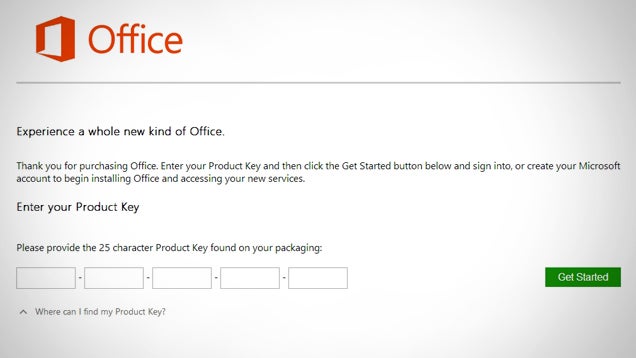
Gratis Download lagu terlaris 2014
Kamis, 08 Mei 2014
tops chips Tops of Chip Bags

Rabu, 30 April 2014
Download and Install Microsoft Office 2013 Without the Disc

If your computer came with Office 2013 pre-installed (or if you lost your installation disc), you can still reinstall Office with your product key—you just need to download it straight from Microsoft.
Head over to officesetup.getmicrosoftkey.com (which is an official Microsoft download page) and enter your product key. This may be on a Certificate of Authenticity included with your computer or a product key card you purchased at a retail outlet. Once you put in that product key, you can then download the appropriate version and install with that same key.
If you registered your copy of Office 2013, you don't even need the product key. Just visit office.microsoft.com, click Install Office, and then log in to your account to download it.
Download Office 2013 From Microsoft Using Product Key | Into Windows
View the Original article
Kamis, 24 April 2014
How to Study Abroad Without Breaking the Bank
 S
S
Studying abroad can be a life-altering and massively enriching experience. Getting out of one's comfort zone and into a learning environment that includes cultural exchange, new surroundings, and gaining a broader world view can be a wonderful experience for students of any age. That experience can also cost a lot of money, and careful planning is crucial to avoid running short or making some bad financial moves after the journey has started, or worse, having to come home because of unexpected financial issues. Here are some tips for keeping costs down and planning well.
This post originally appeared on MyBankTracker.
Going Preplanned or Solo?
There are many ways for students to study abroad, whether in high school or college. Check with the school to learn about exchange programs, group trips, international summer school, and other programs. While it's entirely possible to plan a trip separately from the school and transfer the credits earned, the student's main school may not accept all of the credits, and it may be cheaper to arrange the trip through the school.
Schools may have reduced tuition agreements for their study abroad options, but it's important to know if the student can book their own transportation and other details which might cost less through other means or be discounted with credit card reward points or other programs.
Compare Places and Plan
It may not come as a surprise that the cost of traveling abroad can vary widely by country, but just like in the U.S., the cost of staying in another country can vary greatly by region. The kind of experiences each place will provide will also vary wildly from place to place. If the would-be student traveler doesn't have a location picked out, making a checklist which prioritizes the goals behind the trip can be very useful.
How important is it that English is widely spoken? Access to public transportation? Entertainment? Historical locations? Putting the priorities into place on paper can be very helpful before sitting down to do some serious Googling to see what is out there. And be sure to check with school advisors about programs available, and what affiliated schools in the systems may also have offerings.
Is helping the poor or sharing education with others part of the goal? If this falls high on the priority list, some very low-cost options exist, such as the Peace Corps, and other programs may be available for students to travel abroad and teach English, help with building or planning communities, or other activities. If school credits aren't a big part of the trip goals, volunteering with a charitable organization or church mission program can provide the desired experience without the associated costs. Of course, balancing safety over price tag should be a priority.
If a student who wants to study abroad already has their heart set on a particular place, but the price tag seems out of reach, the same kind of checklist might help in identifying an alternative location.
What Are the Housing Options?
There are many ways for a student to stay in a foreign country. Dormitories, hostels, and host family homes are typical options, but camping may be viable in some locations, or rooms may be available through churches, other school facilities, or by volunteering with a charitable organization with a housing network.
What Will It Take to Get There?
Housing is typically the biggest expense when traveling abroad if a volunteer host family isn't available, but transportation to the host country is often a close second when it comes to cost. Flights can cost several hundred for nearby deals on common routes, or several thousand for flights to remote locations. It is important to budget for major travel expenses.
Food Prices
Don't make the mistake of expecting a food budget to be similar to what it costs to eat everyday meals in the U.S. Food prices can be significantly higher in many places, whether European cities like London or Paris, or remote locations with short growing seasons like Gothenburg, or densely populated cities like Tokyo.
Once the location is selected, do some research to find out what typical meals cost, add those costs up over the period of study, and ideally, plan on spending 10 to percent more than that to be safe. Hopefully with a little research you won't have to break the bank to study abroad.
How to Study Abroad Without Breaking the Bank | MyBankTracker
Shirley Pulawski is a writer in Philadelphia, published in the Huffington Post, Business Insider, the Motley Fool, Investopedia, and print news.
MyBankTracker.com is an independent resource that helps consumers make smarter banking and money decisions.In addition to editorial content, MyBankTracker provides free rate and bank information to consumers on more than 7,000 banks and 30,000 financial products, including credit cards, savings, checking, mortgage and general banking fees.
Images remixed from chrupka (Shutterstock), and Robbi (Shutterstock).
Want to see your work on Lifehacker? Email Andy.
Should I Study Abroad?
Dear Lifehacker, I'm thinking of studying abroad while I'm in college. It seems like it would be a great experience for me, but I have no… Read…
View the Original article
Kamis, 10 April 2014
How to Praise Your Kids Without Spoiling Them
 S
S
You're a good parent and you want to help your kids grow up to be happy and successful. So, when you notice them doing something right, you jump in with praise and encouragement. But is all that praise sending the right message?
This post originally appeared on The Fine Parent.
Turns out the answer is, yes and no.
You've got the first part right—as parents we are our children's first and foremost cheerleaders. Our children need to hear encouragement from us to have a healthy level of self-confidence and self-esteem.
The key however, is to understand what kind of praise is appropriate in which situation.
Think of praise as water. It is like a life force that has the power to help a little acorn grow into a huge oak tree. It has the power to keep everything green and beautiful and growing. But, it also has the power to drown, rot or just mildew everything. The key, like everything, is knowing when and how to use it correctly.
Example: The Budding Artist
 S
S
Consider this sample scenario, adapted from the book Peaceful Parent, Happy Kids: How to Stop Yelling and Start Connecting. Let's say it's one of those rare quiet weekends—for a change you have no other plans and you have the whole morning to yourselves. You ask your daughter what she wants to do, and she chooses to do some art.
Of course, just as you notice how much uninterrupted time you've had to finish up your chores and marvel at how much effort she is putting into it, she walks up to you proudly displaying her painting and asks, "Mom (or Dad), do you like my painting?"
What if she is holding up a mess and you have no clue what it is supposed to be? Let's consider some responses.
How NOT to Praise (and Why)
 S
S
Response 1: Irrespective of whether it is indeed a good painting or not, you put on your best smile and cheerfully say "Wow, great job!" with the best intention of encouraging your child.
Why it's not a good choice: This kind of praise is the least effective since it only provides a momentary good feeling due to the positive attention, but does not give any clue about why it is a "great job."
If we constantly use this kind of praise without moderation (and sadly, most of us do just that!), we may actually turn our kids into praise junkies who will do anything, even a very shabby job, to get their regular fix of a quick feel-good emotion brought on by a "great job."
Here's another nasty side-effect. Sometimes I'm busy and don't have the time to give appropriate attention to what my daughter is showing me and I tend to say "great job" as a quick stand-in for real encouragement. Sadly, this makes "great job" disintegrate into a saccharine version of "go away." And like the story of the boy who cried wolf, when I do mean it as genuine praise, it ends up sending completely wrong signals.
Response 2: Let's say the painting is really good. You are very proud of your child and enthusiastically say, "That's beautiful! You are a natural artist!"
Why it's not a good choice: This kind of praise is the birthplace of the fixed mindset that we so want to avoid.
This statement contains an implicit message that natural talent is what makes someone or something great. From that, the child may extrapolate that if she is seen putting in too much effort then she won't be considered a "natural" any more. And since natural talent is what makes her special, she may not want to let go of that honor and may actually be dissuaded from putting in any effort into getting better. So whatever talent she may have gets stifled with no room to grow.
Also, this is too much of a burden to place on a child—the child now has to live up to the expectation of being a great natural artist every time she paints. Of course we don't mean it that way, but can you think of a harsher way to kill the joy of simply enjoying the creative process?
Response 3: Let's say you have no idea what the painting is about or the painting is rather grotesque. But, you want to be an encouraging parent and so you enthusiastically say, "That's beautiful! You are a natural artist!" anyway.
Why it's not a good choice: At some level our kids know when their work is sub-par. Your daughter may have tried to do something and when it didn't work out, she may have just scribbled over it in frustration. Or she may realize that her proportions are off and the painting looks no good. She comes to you for comfort. When she receives false praise, it confuses her—there is no link between the praise she is receiving and her perception of the situation.
While you may have good intentions, this does more harm than good because it undermines the child's ability to judge her own work and can even creates a sense of shame because mom/dad thinks so highly of her painting "skills" while deep down she worries that she sucks!
Now let's take this a step further. What if your child replies to you with, "I hate it. It's no good!"
Since we started out with "That's beautiful!", chances are we will continue with false praise, and the web of lies gets more and more tangled. This can confuse kids even more by devaluing their own judgement and deepening their sense of frustration/shame.
The Better Way to Praise (and Why)
 S
S
Response 1: Regardless of whether it is indeed a good painting or not, pay real attention to what your child is showing you and say with a smile "You spent a lot of time working on that! What do we have here?"
Why it's a good choice: This response is very different and we have not explicitly praised anything. Yet, to our kids this matters more than any overt praise we try to provide.
Action speaks volumes—stopping what you are doing and paying real attention shows them that they matter and mom/dad cares about what they do. This lays a good foundation for healthy self-esteem as they grow up.
Your words focus on the time they spent working on the painting, something they can be proud of regardless of the end result. When the focus is on the effort, rather than the result, it lays the foundation for finding intrinsic joy in the activity rather than looking for an external source of feel-good emotions.
Response 2: Suppose it is a very good painting and you want to encourage your child by pointing it out, you could again stop what you are doing, give your child complete attention, and then say, "I see you are getting better at painting each day! I remember there was a time you could barely draw a circle and look at you now! So, what do we have here?"
Why it's a good choice: Again, as before, you are giving the child full attention and sending the signal that they are worth it.
However, here you are actually explicitly praising your child's painting. The key difference from the fixed-mindset praise earlier is that your focus is not on any innate talent, but on the amount of effort your child has been putting into it. Talent is not within anybody's control while effort is. So this kind of praise shows the child what they can do more of, if they want to get better at something that they think they are good at.
Also, by being descriptive, you let the child know in easily quantifiable terms that they have made progress. Not to mention, that mom/dad has noticed! And of course, by asking a question in the end instead of leaving it a statement, you open it up for further discussion.
Response 3: Suppose the painting bombed. Again, after you stop what you are doing, you ask your child, "You spent a lot of time working on that! What do we have here?" as before. Chances are the child will blurt out how much she tried to do something but it bombed or may lament that she sucks as painting etc.
Acknowledge her judgement—"Painting faces can be tough... Lots of artists spend years practicing how to get the proportions and expressions just right."
Perhaps offer to help her improve—"Do you want to try art classes to get better at painting faces?" Or, if she is already taking classes, "Why don't we ask Miss Jess next week for some pointers on how to paint faces?" Or, "I think there are some online videos on techniques for painting faces—do you want me to help you look it up?".
Remember, your child may take you up on the offer, or may choose to continue sulking instead. Either are perfectly fine options. If your child was frustrated with the effort and needs to vent out steam, let them.
Why it's a good choice: This is the holy grail of positive reinforcement. The key here is that we are slowly working on taking ourselves out of the equation, and letting our kids find intrinsic motivation in whatever they do. We are teaching them that they are just as talented as the work they are willing to put into it. We are teaching them that they can trust their judgement, and that it's okay for things to not always work out the way they expect. And we are showing them that their value, in our eyes, does not depend on the results they produce, but rather on who they are and the choices they make (in this case, the choice to work hard on that painting). And all the good stuff that goes into making a happy, wholesome, well-adjusted person!
The key takeaway is to focus on effort rather than results, and slowly, over time, more and more of our responses will be helpful to our children.
How to Praise Your Kids the Right Way Without Spoiling Them in the Process| A Fine Parent
Sumitha Bhandarkar is the creator of afineparent.com, a unique personal development blog exclusively for parents. If you're a parent who believes that good parents are made, not born; if you believe that modeling how to live right is far more effective (and fun!) than lecturing; if you're a do-er and not just a planner; click here to join Sumitha and a small group of like-minded parents.
Photos by Jim Pennucci, Faye Pini (2), and Kiselev Andrey Valerevich.
Want to see your work on Lifehacker? Email Andy.
View the Original article
Minggu, 23 Maret 2014
Kings of Parking 3D: fun without real-life obstacles
Features & Use
The basic principles behind Kings of Parking 3D can be quickly described: in each level, the player's task is to maneuver vehicles as quickly as possible to the designated parking area. In the beginning, you’ll quickly master the art of parking, but as the game progresses, the difficulty increases and you are asked to complete much more complex tasks.
 The first level requires a bit of a learning curve, but it's a lot of fun./ © Tiltgames
The first level requires a bit of a learning curve, but it's a lot of fun./ © TiltgamesDivided into levels, the player needs to park the car and beat the clock all while ensuring that no damage is done and that you get three stars. This concept is already known from games like Angry Birds or Plants vs Zombies, however in Kings of Parking 3D, they’ve omitted entirely a framework for action. Here you’ll find the subject of parking under time pressure, packed into a funny story. Though the game is quite good, I feel like there is more room here for growth.
 Like the game on Facebook and you get the Android truck! / © AndroidPIT
Like the game on Facebook and you get the Android truck! / © AndroidPITOverall, the fleet of cars includes four different kinds of vehicles, each level stars one of the four cars. It starts off with a school bus and then the levels become increasingly harder. Next to the bus, there’s a sedan, a sports car and the Android truck, which can be unlocked only with a "Like" on Facebook. In the free version, you need to complete a chapter before having access to the next one.
 You'll find the high scores under ''Check-in''. / © AndroidPIT
You'll find the high scores under ''Check-in''. / © AndroidPITOverall Kings of Parking 3D was well done, although I found the total length of the game to be too short. Given the fact that it is free, I wouldn’t say that this is a negative point. There is still room for improvement in their choice for the controls. Although the developer implemented the MOGA controller just recently, more options for on-screen operation would have been appreciated. For example, the size of controllers or an adjustment to the camera angles.
Screen & Controls
In a game like Kings of Parking 3D, it’s difficult to make a distinction between controls and functionality. How fun the game is, is significantly influenced by the game’s controls, especially in this genre.
Although it was generally well done, there is still room for improvement. The automatic camera is particularly frustrating because it switches on its own which isn’t always to your advantage. With limited parking maneuvers, the perspective would suddenly change and the player loses important parts of the image.
Though you are able to switch to a manual camera, this costs you valuable seconds from your score. A setting for the behavior of the automatic camera before started a level would be great.
The other controls for Kings of Parking 3D are otherwise very well done, even if the player goes through a certain learning curve at the start of the game. After a few minutes of play, the controls are no longer a problem and a high score can be achieved.
The graphics were also very well done, though at times the corners and edges of the game would disappear.
Speed & Stability
During our testing period, no crashes at Kings of Parking 3D were noticed.
Price/Performance Ratio
Kings of Parking 3D is ad-supported and is available for free. For 99 cents, all the levels can be unlocked. Furthermore, the application is then ad-free.
 Der erwähnte In-App-Einkauf. / © AndroidPIT
Der erwähnte In-App-Einkauf. / © AndroidPITFinal Verdict
Kings of Parking 3D is a successful game. Without question, the app is fun, though after a certain time, it can become monotonous. It sometimes seemed as if the application was missing a few finishing touches, like some advanced settings for the automatic camera and a broader fleet. Nevertheless, installing Kings of Parking 3D is worth it.
View the Original article














